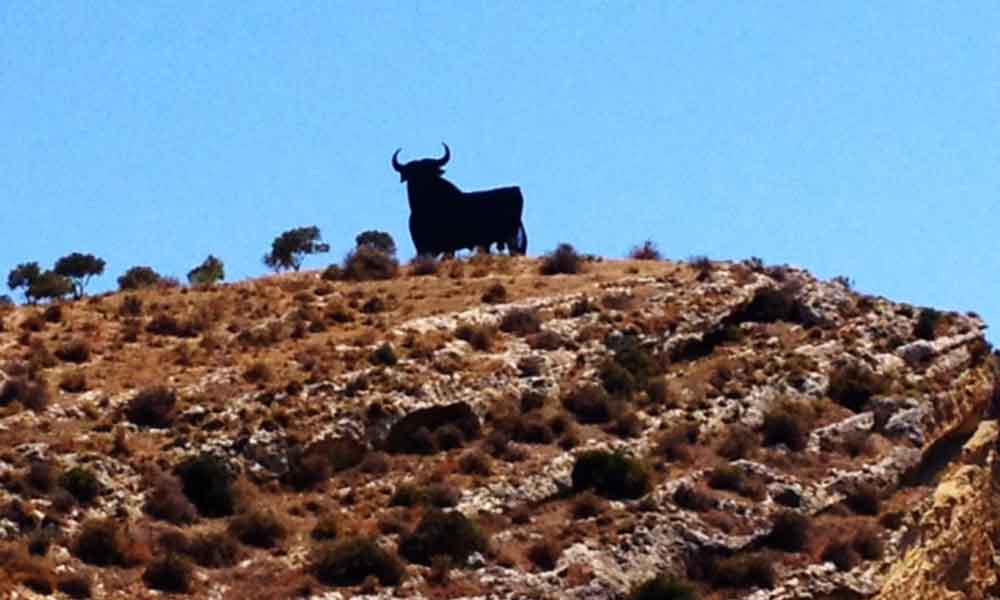-
27
Sep 2015
The Osborne bull; The symbol of Spanish culture

When we go to Torre del Mar we always look forward to seeing the Osborne Bull looming up as we approach, an amazing sight. In total Osborne has 97 of such bulls throughout Spain designed by the acclaimed artist Manolo Prieto. Each bull is made of iron and has a surface of 150 m2, is more than 14 meters high and weighs about 4,000 kilograms. The first was installed in 1957 in Canabillas de la Sierra in the province of Burgos. In the heyday of the bull, there were more than 500 on the landscape. Most of the remaining bulls are now in the Marco de Jerez, the sherry area around Jerez de la Frontera in the provinces of Cadiz and Seville. The rest are randomly scattered throughout Spain on the roads which lead from Madrid to Barcelona, Bilbao, La Coruña, Badajoz, Cadiz and Valencia. Usually they are placed on ridges to break the horizon where they are more visible against the sky. In Andalusia there are in total 23 of which only one in the region of Axarquia; the one in Torre del Mar.
It all started as advertising material
The Bull was originally designed as a billboard for Veterano Brandy from Jerez made by the Osborne Group, as you may know, a spirits producer. The first signs were made in 1957, then still made of wood. They were only four meters high with white horns and a sign with the name of the drink. The wooden boards were not found to be resistant to the weather, so they were replaced by plates of sheet steel and the size was increased up to 7 m high. A reference regarding the sign standard in 1962 stated that signs along the road could be increased to 14 meters so this was the target of the original signs to advertise the brand and in the course of time they have become a symbol of Spanish culture.
Not without a fight
But that was not the end of the story; in September 1994 the Spanish roads decree required that all Osborne bulls had to be removed. Many municipalities, cultural organizations, artists, politicians and journalists, however spoke out for retaining the signs. The Junta de Andalucía requested inventory as cultural heritage and the Comunidad Foral de Navarra relies on customary to keep the bulls in their place. Only three years later, in December 1997, the Spanish Supreme Court called for the signs to be retained on the basis of "aesthetic or cultural significance". From 1998, the "Osborne Bull" remains a Spanish symbol. Although not an official expression of the Spanish identity, the bull located in El Bruc, Catalonia was boycotted and eventually demolished by the Catalan nationalist movement. Catalan nationalists have adopted the Catalan donkey as their own symbol. Only months later, a bull returns back to its place in the hills along the Catalan roads the result of hard working local enthusiasts.
A commercial success
Since the late 90s, the image of the Osborne bull can be seen again and again in everyday life: as a sticker on souvenirs ranging from T-shirts, ties, towels, coasters, ashtrays, key fobs, tiles, wall decoration, caps, and as the arms on the Spanish flag and occasionally on the uniforms of Spanish soldiers at sports events and international missions. The bull is a commercial logo, no one except the Osborne GOEP can use the mark without their consent. Meanwhile, the licensing of the logo has become a major source of income. Today the Osborne bull represents much more than just promoting a brandy. He is symbolic of Spain and has served as advertising, as an illustration in The New York Times in an article about the death of Franco and a source of inspiration for poets, writers, painters, photographers and filmmakers. We are also very fond of him; we even have a miniature version of him in our garden in the Netherlands !
Un saludo cordial,
Jan & Marita